
Technique_No. 6
Scenarios

February, 2000
Professor Jeffrey Huang and Muriel Waldvogel seem lost in thought as they ponder scale models of the Swisshouse, the new Swiss consulate facility to be built in Boston, Massachusetts . . .
. . . Huang and Waldvogel were brought in to conceive the architectural design of the building, which, rather than issuing visas, will serve as a networking and knowledge exchange hub. The two are studying several scenarios of how people will use the Swisshouse, and have constructed both physical models and screenplay-like texts designed to make tangible the purpose of this unprecedented government facility.
One scenario describes Nicolas, a brain surgeon who has just moved to Boston from Switzerland. He visits the Swisshouse to meet likeminded scientists and other members of the Swiss-American community. A second scenario tells the story of a Professor Smith, who uses the Swisshouse to present his MIT Media Lab research to Boston’s Swiss community and to academics at two Swiss universities, using a high-speed Internet connection.
These scenarios, while simple, are the result of intensive research into roles the new type of consulate might play. The stories illustrate the Swiss government’s intentions and serve as thinking tools to guide the building’s design. Ultimately, the new facility effectively accommodated the applications imagined and fulfilled its objectives.
Today, almost a decade after its conception, the Swisshouse enjoys an outstanding reputation for helping build stronger international ties in greater Boston’s science and technology communities. Under the banner of the Swiss Knowledge Network, or swissnex, the Swisshouse has inspired “colleague” facilities in Bangalore, San Francisco, Shanghai, and Singapore.
Scenario-Guided Business Model Design
Scenarios can be useful in guiding the design of new business models or innovating around existing models. Like visual thinking, prototyping, and storytelling, scenarios render the abstract tangible. For our purposes, their primary function is to inform the business model development process by making the design context specific and detailed.
Here we discuss two types of scenarios. The first describes different customer settings: how products or services are used, what kinds of customers use them, or customer concerns, desires, and objectives. Such scenarios build on customer insights, but go a step further by incorporating knowledge about customers into a set of distinct, concrete images. By describing a specific situation, a customer scenario makes customer insights tangible.
A second type of scenario describes future environments in which a business model might compete. The goal here is not to predict the future, but rather to imagine possible futures in concrete detail. This exercise helps innovators reflect on the most appropriate business model for each of several future environments. The strategy literature discusses this practice in detail under the topic of “scenario planning.” Applying scenario planning techniques to business model innovation forces reflection on how a model might have to evolve under certain conditions. This sharpens understanding of the model, and of potentially necessary adaptations. Most important, it helps us prepare for the future.

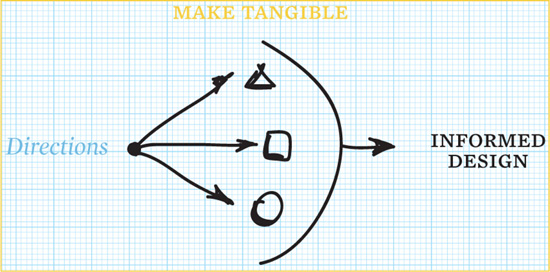
Explore Ideas
Customer scenarios guide us during business model design. They help us address issues such as which Channels are most appropriate, which relationships would be best to establish, and which problem solutions customers would be most willing to pay for. Once we’ve generated scenarios for different Customer Segments, we can ask ourselves whether a single business model is sufficient to serve them all—or if we need to adapt the model to each segment.
Here are three different scenarios describing location-based services that make use of Global Positioning Systems (GPS). They inform the business model design, but are deliberately left open to allow for specific questions around the Value Proposition, Distribution Channels, Customer Relationships, and Revenue Streams. The scenarios are written from the standpoint of a mobile telephone service operator working to develop innovative new business models.
THE HOME DELIVERY SERVICE
Tom has always dreamed of running his own small business. He knew it would be difficult, but earning a living by living his passion was definitely worth working more and earning less.
Tom is a film buff whose knowledge of movies is encyclopedic, and that’s what customers of his home-delivery DVD movie service appreciate. They can query him about actors, production techniques, and just about anything else film-related before ordering movies for delivery to their doorsteps.
Given the formidable online competition, it’s hardly an easy business. But Tom’s been able to boost his productivity and improve customer service with a new GPS-based delivery planner acquired from his mobile phone operator. For a small fee he equipped his phone with software that easily integrated with his Customer Relationship management program. This software won back much of Tom’s time by helping him better plan delivery routes and avoid traffic. It even integrated with the cell phones used by two aides who help out on weekends when demand for his service peaks. Tom knows his little business will never make him rich, but wouldn’t trade his situation for any corporate job.
• Is the value added sufficient to motivate delivery services to pay monthly fees?
• Through which Channels could such Customer Segments most easily be reached?
• With what other devices and/or software would this service need to be integrated?
THE TOURISTS
Dale and Rose are traveling to Paris for an extended weekend. They are excited because they haven’t visited Europe since their honeymoon 25 years ago. The couple organized this mini-escape from everyday work and family life just two weeks before departure, leaving their three kids with parents back in Portland. Lacking time and energy to plan the trip in detail, they decided to “wing it.” As a consequence, they were intrigued to read an article in the inflight magazine about a new GPS-based tourist service that uses mobile phones. Dale and Rose, both technology fans, rented the recommended handset upon arrival at Charles de Gaulle airport. Now they’re happily strolling around Paris on a customized tour proposed by the compact device—all without having consulted a single traditional tourist guide. They particularly appreciate the built-in audio guide that suggests various story and background information options as they approach particular sites. On the return flight, Dale and Rose muse about relocating to Paris after retiring. Laughing to themselves, they wonder whether the handy device would be enough to help them adapt to French culture.
• Should the service be based on a proprietary device or on an application that can be downloaded to customer handsets?
• Could airlines serve as Channel partners to distribute the service/device?
• Which prospective content partners would be interested in being part of the service?
• Which Value Propositions would customers be most willing to pay for?
THE WINE FARMER
Alexander inherited vineyards from his father, who in turn inherited them from Alexander’s grandfather, who emigrated from Switzerland to California to grow wine. Carrying on this family history is hard work, but Alexander enjoys adding small innovations to his family’s long wine-growing tradition.
His latest discovery is a simple land management application that now resides on his mobile phone. Though not aimed at vintners, it was designed in such a way that Alexander was easily able to customize it for his own particular needs. The application integrates with his task list, which means he now has a GPS-based to-do list that reminds him when and where to check soil or grape quality. Now he’s pondering how to share the application with all of his managers. After all, the tool makes sense only if everyone on the management team updates the soil and grape quality database.
• Is the value added sufficient to motivate a landowner to pay a monthly service fee?
• Through which Channels could such Customer Segments most easily be reached?
• With what other devices and/or software would this service need to be integrated?
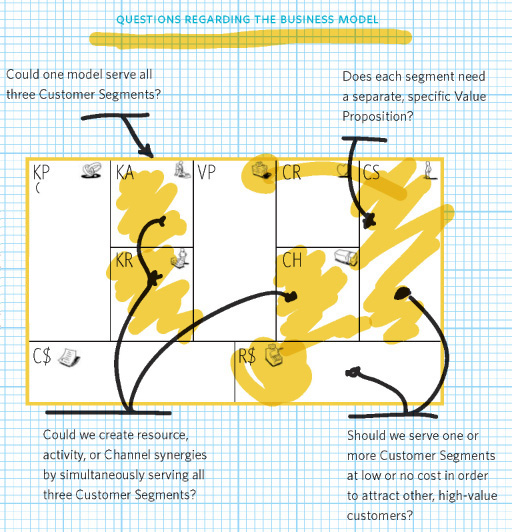
Future Scenarios
The scenario is another thinking tool that helps us reflect on business models of the future. Scenarios kick-start our creativity by providing concrete future contexts for which we can invent appropriate business models. This is usually easier and more productive than free brainstorming about possible future business models. It does require, however, developing several scenarios, which can be costly depending on their depth and realism.
One sector under strong pressure to devise innovative new business models is the pharmaceutical industry. There are a number of reasons for this. Major player research productivity has declined in recent years, and these companies face enormous challenges discovering and marketing new blockbuster drugs—traditionally the core of their businesses. At the same time, patents on many of their cash cow drugs are expiring. This means revenues from those drugs are likely to be lost to generic drug manufacturers. This combination of empty product pipelines and evaporating revenue are just two headaches plaguing incumbent pharmaceutical makers.
In this turbulent context, combining business model brainstorming with the development of a set of future scenarios can be a powerful exercise. The scenarios help trigger out-of-the-box thinking, which is not always easy when trying to develop innovative business models. Here’s an overview of how such an exercise might be conducted.
First, we must devise a set of scenarios that paint pictures of the future of the pharmaceutical industry. This is best left to scenario planning specialists equipped with the right tools and methodology. To illustrate, we developed four bare bones scenarios based on two criteria that may shape the evolution of the pharma industry over the next decade. There are, of course, several other drivers and many different scenarios that could be crafted based on deeper research into the industry.
The two drivers we’ve selected are (1) the emergence of personalized medicine and (2) the shift from treatment toward prevention. The former is based on advances in pharmacogenomics, the science of identifying underlying causes of diseases based on a person’s DNA structure. Someday, this may result in completely personalized treatment, using customized drugs based on a person’s genetic structure. The shift from treatment to prevention is driven in part by pharmacogenomics, in part by advances in diagnostics, and in part by renewed cost-consciousness amid growing awareness that prevention is less expensive than hospitalization and treatment. These two drivers suggest trends that may or may not materialize and thus provide four scenarios illustrated in the figure opposite. These are:
• BUSINESS AS USUAL: Personal medicine fails to materialize despite its technological feasibility (e.g. for privacy reasons, etc.) and treatment remains the core revenue generator.
• MY.MEDICINE: Personal medicine materializes, but treatment remains the core revenue generator.
• THE HEALTHY PATIENT: The shift toward preventive medicine continues, but personal medicine remains a fad despite technological feasibility.
• REINVENTING PHARMA: Personal and preventive medicine comprise the new growth areas of the drug industry.
Pharma Business Models of the Future
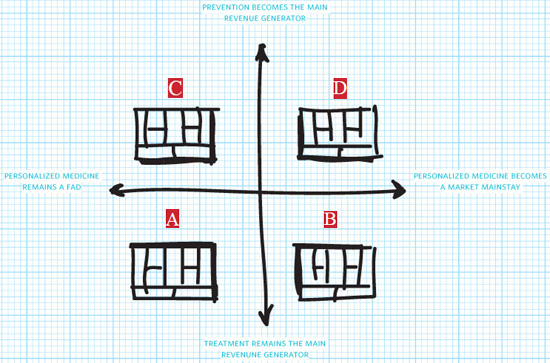
C) The Healthy Patient:
• What kind of Customer Relationship does effective preventive medicine require?
• Who are the main partners we should involve in developing our business model for preventive medicine?
• What does the shift toward preventive medicine imply about the relationship between doctors and our salespeople?
D) Reinventing pharma:
• What does our Value Proposition look like in this new landscape?
• What roles will Customer Segments play under our new business model?
• Should we develop relevant activities, such as bioinformatics and gene sequencing, in-house or through partnerships?
A) Business as Usual
• How will our business model look in the future if these two drivers don’t change?
B) My.medicine
• What kinds of relationships will we have to establish with patients?
• Which Distribution Channels are most appropriate for personalized medicine?
• Which resources and activities, such as bioinformatics and gene sequencing, do we need to develop?
Scenario D: Reinventing Pharma
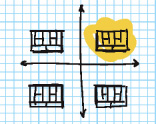
The landscape of the pharmaceutical industry has completely changed. Pharmacogenomic research has fulfilled its promise and is now a core part of the industry. Personalized drugs tailored to individual genetic profiles account for a large portion of industry revenues. All this has increased the importance of prevention—and is partially replacing treatment, thanks to substantially improved diagnostic tools and a better understanding of the links between diseases and individual genetic profiles.
These two trends—the rise of personalized drugs and the increasing importance of prevention—have completely transformed the traditional pharmaceutical manufacturing business model. The twin trends have had a dramatic impact on pharma’s Key Resources and Activities. They’ve transformed the way drug makers approach customers and provoked substantial changes in how revenue is generated.
The new pharma landscape has taken a heavy toll on incumbents. A number were unable to adapt quickly enough and disappeared or were acquired by more agile players. At the same time, upstarts with innovative business models were able to acquire significant market share. Some were themselves acquired and integrated into the operations of larger but less nimble companies.
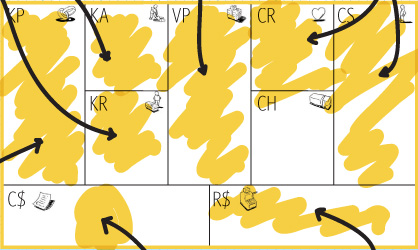
KP Which partnerships will maximize the effectiveness of a drug company’s new business model?
KA & KR What new Key Resources and Key Activities will provide a competitive advantage when personalized drugs and prevention are the industry’s main focus?
VP What are the attributes of a competitive Value Proposition under the new landscape?
CR &CS What roles will Customers and Customer Relationships play when personalized drugs are an industry mainstay?
C$ How will the Cost Structure of a pharmaceutical company’s business model change under this new landscape?
R$ How will revenues be generated when the focus is on personalized drugs and prevention?
Future Scenarios and New Business Models
1 DEVELOP A SET OF FUTURE SCENARIOS BASED ON TWO OR MORE MAIN CRITERIA.

2 DESCRIBE EACH SCENARIO WITH A STORY THAT OUTLINES THE MAIN ELEMENTS OF THE SCENARIO
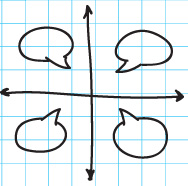
3 WORKSHOP DEVELOP ONE OR MORE APPROPRIATE BUSINESS MODELS FOR EACH SCENARIO

The goal of combining scenarios with business model innovation efforts is to help your organization prepare for the future. This process engenders meaningful discussion about a difficult topic, because it forces participants to project themselves into concrete “futures” underpinned by hard (though assumed) facts. When participants describe their business models they must be able to make a clear case for their choices within the context of the specific scenario.
Scenarios should be developed before the business model workshop begins. The sophistication of the “screenplays” will vary depending on your budget. Keep in mind that once you develop scenarios, they may be usable for other purposes as well. Even simple scenarios help jumpstart creativity and project participants into the future.
Ideally you should develop between two and four different scenarios based on two or more criteria in order to run a good business model scenario workshop. Each scenario should be titled and described with a short, specific narrative outlining the main elements.
Begin the workshop by asking participants to review the scenarios, then develop an appropriate business model for each. If your objective is to maximize a group’s understanding of all the potential futures, you might want everyone to participate in a single group and let them collectively develop different business models for each scenario. If you are more interested in generating a set of very diverse future business models, you might decide to organize participants into different groups that work in parallel on separate solutions for the various scenarios.
Further Reading on Design and Business
Design Attitude
Managing as Designing
by Richard Boland Jr. and Fred Collopy (Stanford Business Books, 2004)
A Whole New Mind: Why Right-Brainers Will Rule the Future
by Daniel H. Pink (Riverhead Trade, 2006)
The Ten Faces of Innovation: Strategies for Heightening Creativity
by Tom Kelley (Profile Business, 2008)
Customer Insights
Sketching User Experiences: Getting the Design Right and the Right Design
by Bill Buxton (Elsevier, 2007)
Designing for the Digital Age: How to Create Human-Centered Products and Services
by Kim Goodwin (John Wiley & Sons, Inc. 2009)
Ideation
The Art of Innovation: Lessons in Creativity from IDEO, America’s Leading Design Firm
by Tom Kelley, Jonathan Littman, and Tom Peters (Broadway Business, 2001)
IdeaSpotting: How to Find Your Next Great Idea
by Sam Harrison (How Books, 2006)
Visual Thinking
The Back of the Napkin: Solving Problems and Selling Ideas with Pictures
by Dan Roam (Portfolio Hardcover, 2008)
Brain Rules: 12 Principles for Surviving and Thriving at Work, Home, and School
by John Medina (Pear Press, 2009) (pp. 221–240)
Prototyping
Serious Play: How the World’s Best Companies Simulate to Innovate
by Michael Schrage (Harvard Business Press, 1999)
Designing Interactions
by Bill Moggridge (MIT Press, 2007) (ch. 10)
Storytelling
The Leader’s Guide to Storytelling: Mastering the Art and Discipline of Business Narrative
by Stephen Denning (Jossey-Bass, 2005)
Made to Stick: Why Some Ideas Survive and Others Die
by Chip Heath and Dan Heath (Random House, 2007)
Scenarios
The Art of the Long View: Planning for the Future in an Uncertain World
by Peter Schwartz (Currency Doubleday, 1996)
Using Trends and Scenarios as Tools for Strategy Development
by Ulf Pillkahn (Publicis Corporate Publishing, 2008)
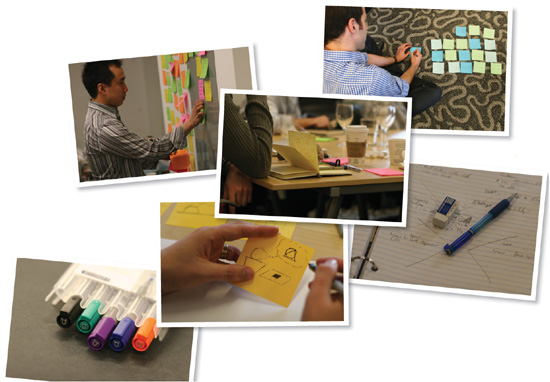
Do you have the guts to start from scratch?
WHAT STANDS IN YOUR WAY?
In my work with non-profit organizations, the biggest obstacles to business model innovation are 1. inability to understand the existing business model, 2. lack of a language to talk about business model innovation, and 3. counterproductive constraints on imagining the design of new business models.
Jeff De Cagna, United States
The management of an SME (wood manufacturing industry-WMI) did not begin changing its business model until the bank no longer wanted to give them credit. The biggest obstacle to business model innovation (in the WMI case and likely every case) is the people who resist any changes until problems appear and need corrective actions.
Danilo Tic, Slovenia
EVERYONE LOVES INNOVATION UNTIL IT AFFECTS THEM. The biggest obstacle to business model innovation is not technology: it is we humans and the institutions we live in. Both are stubbornly resistant to experimentation and change.
Saul Kaplan, United States
I have found that the management and key employees in many SME companies lack a common framework and language for discussing business model innovation. They do not have the theoretical background, but they are essential to the process because they are the ones who know the business.
Michael N. Wilkens, Denmark
METRICS OF SUCCESS: They can direct the scope and ambition of behavior. At best they can allow for the agility that brings truly disruptive innovation; at worst they reduce vision to near term iterative cycles of evolution that fail to take opportunity from changing environments.
Nicky Smyth, U.K.
Fear to take risks. As a CEO you need courage to take a business model innovation decision. In 2005, Dutch telecom provider KPN decided to migrate proactively to IP and thus to cannibalize its traditional business. KPN is now internationally recognized as an outperformer in the telco industry.
Kees Groeneveld, Netherlands
In my experience with a large archive, the biggest hurdle was to make them understand that even an archive has a business model. We overcame this by starting a small project and showed them this would affect their current model.
Harry Verwayen, Netherlands
GET EVERYBODY INVOLVED and keep up the speed of change. For our disruptive meeting concept Seats2meet.com we trained the staff almost daily for a period of four months just on communicating this new business model to all stakeholders.
Ronald van Den Hoff, Netherlands
1. Organizational antibodies that attack a project as resources drawn from their area conflict with their business objectives. 2. Project management processes that can’t deal with risks/uncertainties associated with bold ideas so leaders decline or claw ideas back to existing comfort zones.
John Sutherland, Canada
The biggest obstacle is a belief that models must contain every detail—experience shows that clients ask for a lot but settle for simplicity once they have insight into their business.
David Edwards, Canada
1. Not knowing: What is a business model? What is business model innovation? 2. Not able: How to innovate a business model? 3. Not willing: Why should I innovate my business model? Is there a sense of urgency? 4. Combinations of the above.
Ray Lai, Malaysia
In my experience, the biggest obstacle is failure to change the thinking process from the traditional linear way to holistic and systemic. Entrepreneurs need to make a concerted effort to develop the capability to envision the model as a system whose parts interact with each other and affect each other in a holistic and non-linear manner.
Jeaninne Horowitz Gassol, Spain
As an Internet marketer for 15 years I’ve seen new business models live and die. The key for the winners was that the major stakeholders completely understood and advanced the model.
Stephanie Diamond, United States
THE MENTAL MODELS of executives and the board. The lack of candor and fear of deviating from the status quo sets in groupthink. Executives are comfortable with exploit phase and not ‘explore’ phase, which is unknown and hence risky.
Cheenu Srinivasan, Australia
In my experience as an Internet entrepreneur and investor, the biggest obstacles are lack of vision and bad governance. Without good vision and governance a company will miss the emerging industry paradigm and avoid reinventing the business model in time.
Nicolas De Santis, U.K.
Within large multinationals it is key to create cross-functional understanding and synergies. Business model innovation does not hold itself to the organizational constraints that the people in it experience. For successful execution it is key to have all disciplines on board and interconnected!
Bas van Oosterhout, Netherlands
FUG: FEAR, UNCERTAINTY & GREED of the people vested in the current business model. . .
Frontier Service Design, LLC, United States
A lack of entrepreneurship in the organization. Innovation is about taking risks, wisely. If there is no room for creative insights or if people can’t think and act outside the boundaries of the existing model, don’t even try to innovate: you will fail.
Ralf de Graaf, Netherlands
On an organizational level, the biggest obstacle for a large, successful company is a reluctance to risk doing anything that may jeopardize their current model. On a leader/personal level, their very success was likely a product of the current business model...
Jeffrey Murphy, United States
“If it ain’t broke, don’t fix it” thinking. Established companies stick to current ways of doing business until it is obvious that the customers want something else.
Ola Dagberg, Sweden
STRENGTH OF LEADERSHIP can be an obstacle. Risk management and due diligence color the perceived purpose of many boards. Where innovation is assessed as a risk issue it’s easy to relegate it to tokenism, especially within cultural institutions that tend not to have championing cultures. Here innovation often dies the death of a thousand cuts inflicted by entrenched critical business processes, instead of being placed front and center as the fuel for future strategy.
Anne McCrossan, U.K.
Oftentimes, companies design an innovative business model, but do a poor job of constructing a compensation structure that is properly aligned with the model and its objectives.
Andrew Jenkins, Canada
CURRENT SUCCESS prevents companies from asking themselves how their business model could be innovated. Organizational structures are not typically designed for new business models to emerge.
Howard Brown, United States
The companies that are the most successful in continuously improving the efficiency of their current business model often get blinded by “this is the way things are done in our business” and fail to see the emergence of innovative business models.
Wouter van der Burg, Netherlands